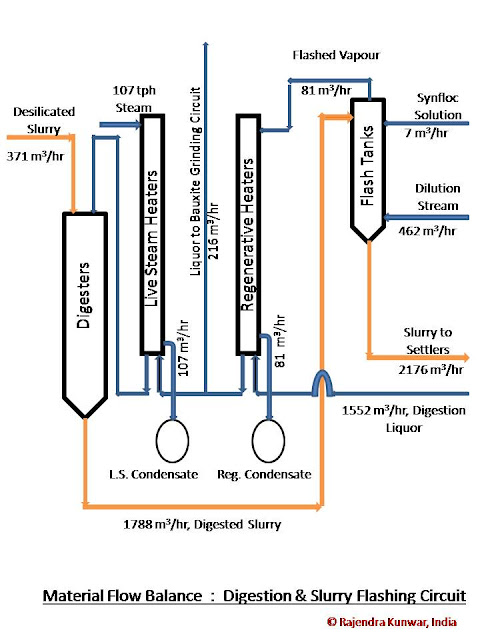Hi Friends,
Start up and commissioning of Alumina refinery is taken up after following activities-
In present post, we will discuss the operational sequence for starting and commissioning of Alumina refinery. As such, there may be many permutations and combinations of operational sequence for starting and commissioning of Alumina refinery. We are presenting here one of them which may be simple and most appropriate. The schematic diagram is presented here under-
- Thorough checking for Mechanical completion,
- Readiness of raw water supply system and DM plant,
- Synchronization of boilers and turbo-generators,
- Cold water run and
- Hot water run.
- Ensuring the availability of adequate input materials.
Caustic concentration build up and raising its temperature to around 85 degree centigrade are pre-commissioning activities required for start up of Alumina refinery. Sequence of caustic concentration build up, temperature raising, start up and commissioning steps are taken up in following sequence-
- Fresh caustic lye received by road / rail tankers are stored in Caustic storage tanks (CSTs) and 6 or 7 nos. precipitators of 2nd line as 1st line precipitators shall be taken into range for commissioning.
- Initially, Evaporator feed tank, Liquor preparation tank, Digesters, Flash tanks, Heaters and one of the Decanters are taken into range for concentration build up and temperature raising. Accordingly closed circuit with these equipment is made by temporary connections for circulation of liquor before start up.
- Water is taken in Evaporator feed tank through temporary lines and operation of evaporator is initiated at low vacuum and operation is stabilized slowly with boiling. This ensures the adequate condensate supply to boilers as well as hot water for dilution of caustic lye to around 150 to 200 gpl caustic in Liquor preparation tank.
- Run the Test tank pump at about 50% flow for filling Heaters, Digesters and Decanter connected in the circuit. Keep the drain valves of Heaters in open condition in the beginning for purging out entrapped air in pipelines otherwise it may cause damage to chambers of heaters.
- Open steam in Live steam heater maintaining the outlet temperature below 100 degree centigrade.
- Circulation of liquor in this circuit is continued for about 24 hours for checking the readiness of process circuit.
- Start Bauxite charging to grinding mill at about 50% digestion liquor flow and taking charging ratio at around 0.300. Bauxite charging to grinding circuit is considered as start of plant commissioning i.e. Zero hour of plant commissioning.
- Two desilication tanks will be filled up with slurry taking Bauxite slurry heaters into service. After attaining about 16 hours of desilication time, temporary circuit of Red area will be discontinued and permanent process circuit will be energized for generation of spent liquor.
- Start flocculent preparation and dosing to settler as required.
- Initially Security filters will be operating as a spool but will be taken into range afterwards for ensuring required purity of plant liquor.
- Heat Interchange Unit will be kept bypassed and filling of precipitators shall be started taking only five (5) precipitators in range for the purpose of adequate seed generation.
- Continue circulation of Precipitation liquor through Evaporators and Digesters for slowly raising the temperature profile of liquor.
- Slowly increase the digestion liquor concentration to around 250 gpl caustic and step up charging ratio to around 0.620 level for raising the ratio profile of aluminate liquor to the level of pregnant liquor.
- Take Residue washers into circuit.
- After attaining the aluminate liquor ratio above 0.600 in feed liquor of Precipitation tanks, start seeding with purchased solid hydrate at controlled rate for generation of seed hydrate. For the purpose, solid hydrate will be mixed in Seed mixing tank with Pregnant liquor and pumped to those five (5) Precipitation tanks taken in range.
- Maximize charging ratio to the desired saturation level and increase Bauxite charge at increase digestion liquor flow.
- Hydrate generated in Precipitation circuit will be used as seed till adequate hydrate is built up in the process.
- Discontinue all temporary connections and continue operation as normal by taking desired number of equipment and vessels of one line of process circuit.
- Start hydrate classification circuit and transfer of product hydrate to Hydrate storage shed.
- After making a stock of about 20,000 tonnes of hydrate in storage shed, commission Calciner for production of calcined alumina.
- Stabilize plant operation for maximizing alumina production level.
Hope, starting and commissioning procedure for Alumina refinery has been covered with clarity in understanding.
Please put your views / suggestions / remarks / comments, if any.
Regards.
Kunwar Rajendra







